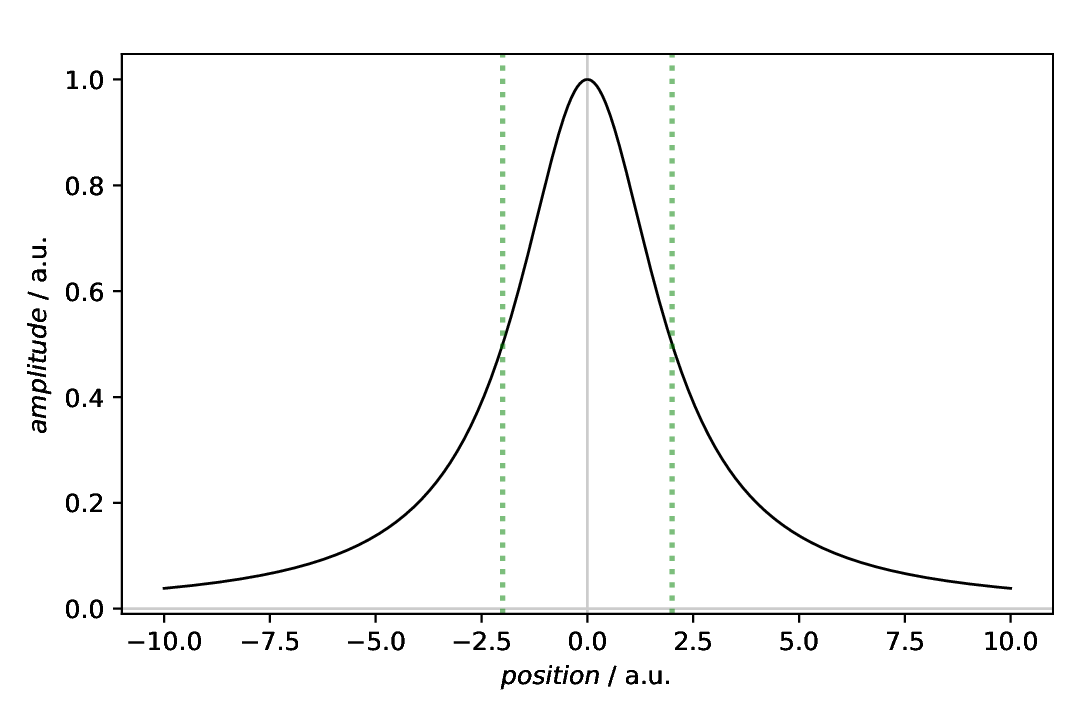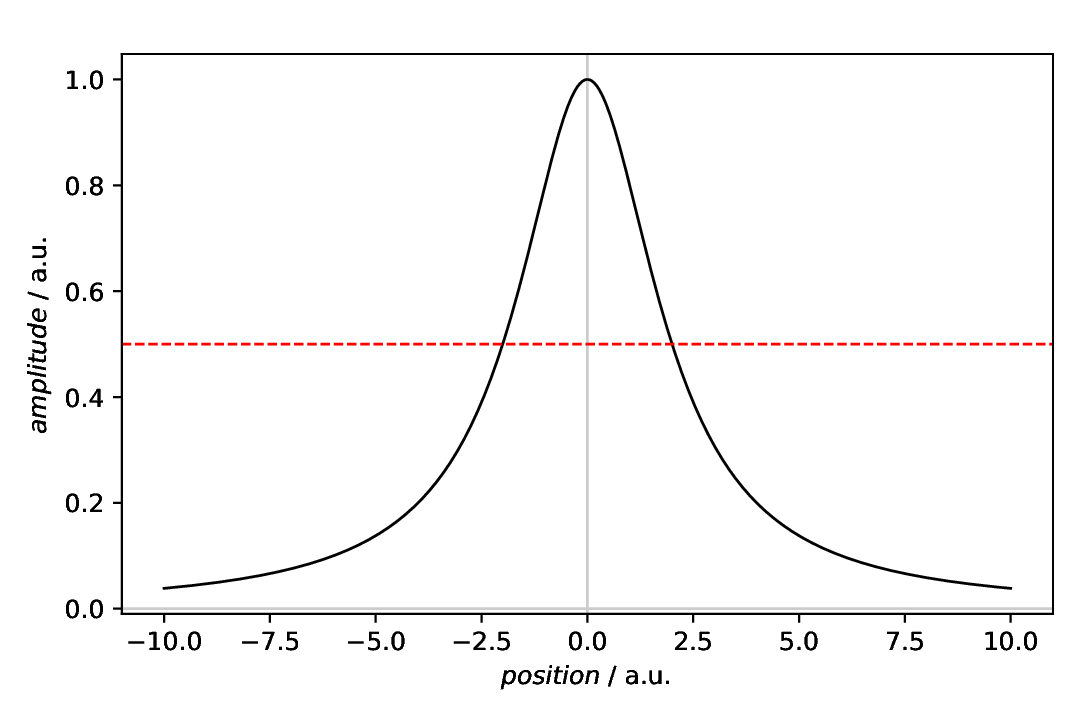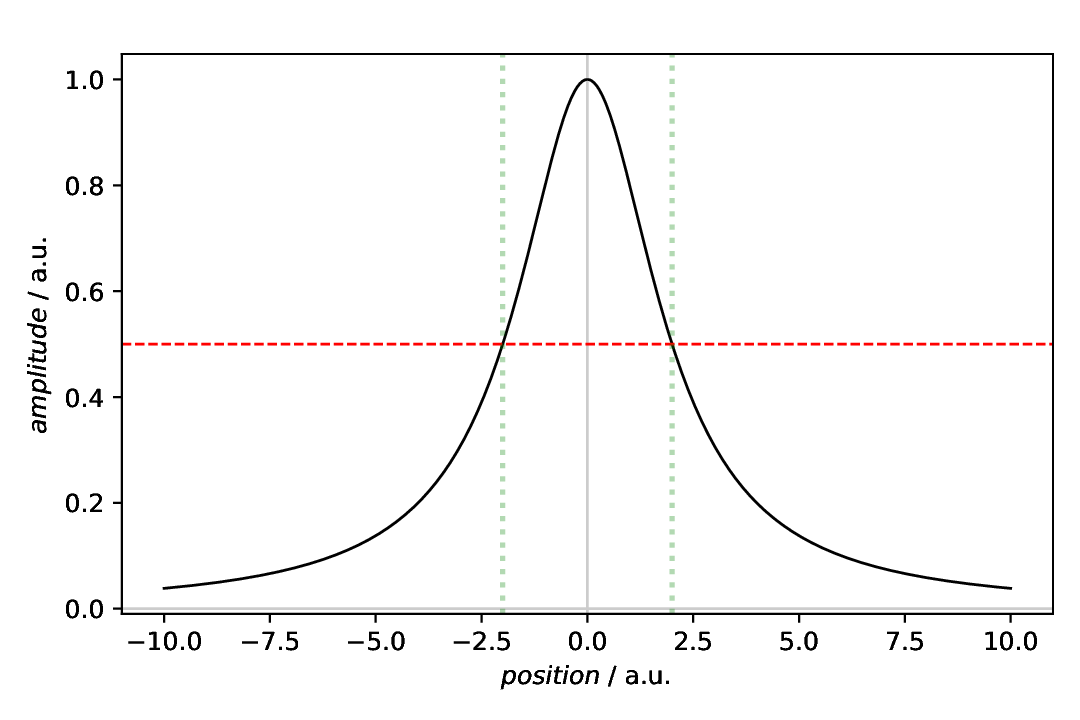You're reading an old version of this documentation. For up-to-date information, please have a look at v0.12.
Plot annotations: Lines
Classes used:
Models:
Plotting:
Annotations:
Graphical representation of data and results is one of the most important aspects of presenting scientific results. A good figure is a figure allowing the reader to immediately catch the important aspects, not relying on reading the (nevertheless always important) caption with more description.
To this end, there is the frequent need to annotate figures, i.e. add additional lines, areas, or even text. This is what can be done with the concrete subclasses of aspecd.annotation.PlotAnnotation.
Here, we focus on simple vertical and horizontal lines added to a plot that are often used as a guide to the eye of the reader.
Recipe
Shown below is the entire recipe. As this is quite lengthy, separate parts will be detailed below in the “Results” section.
1format:
2 type: ASpecD recipe
3 version: '0.2'
4
5settings:
6 autosave_plots: False
7
8tasks:
9 - kind: model
10 type: Zeros
11 properties:
12 parameters:
13 shape: 1001
14 range: [-10, 10]
15 result: dummy
16
17 - kind: model
18 type: Lorentzian
19 from_dataset: dummy
20 properties:
21 parameters:
22 width: 2
23 result: model_data
24 comment: >
25 Create Lorentzian with width set explicitly
26
27 - kind: singleplot
28 type: SinglePlotter1D
29 properties:
30 properties:
31 axes:
32 xlabel: "$position$ / a.u."
33 parameters:
34 tight_layout: True
35 filename: plotting-annotation-lines-vertical.pdf
36 apply_to:
37 - model_data
38 result:
39 - plot-with-vertical-lines
40 comment: >
41 Plotter that gets annotated later
42
43 - kind: plotannotation
44 type: VerticalLine
45 properties:
46 parameters:
47 positions: [-2, 2]
48 properties:
49 color: green
50 linewidth: 2
51 linestyle: dotted
52 alpha: 0.3
53 plotter: plot-with-vertical-lines
54 result: vertical-lines
55 comment: >
56 Two styled vertical lines marking the FWHM
57
58 - kind: plotannotation
59 type: HorizontalLine
60 properties:
61 parameters:
62 positions: [0.5]
63 properties:
64 color: red
65 linewidth: 1
66 linestyle: dashed
67 result: horizontal-line
68 comment: >
69 Styled horizontal line marking the FWHM, used later in plot
70
71 - kind: singleplot
72 type: SinglePlotter1D
73 properties:
74 properties:
75 axes:
76 xlabel: "$position$ / a.u."
77 parameters:
78 tight_layout: True
79 filename: plotting-annotation-lines-horizontal.pdf
80 apply_to:
81 - model_data
82 annotations:
83 - horizontal-line
84 comment: >
85 Plotter using an existing annotation
86
87 - kind: singleplot
88 type: SinglePlotter1D
89 properties:
90 properties:
91 axes:
92 xlabel: "$position$ / a.u."
93 parameters:
94 tight_layout: True
95 filename: plotting-annotation-lines-both.pdf
96 apply_to:
97 - model_data
98 annotations:
99 - horizontal-line
100 - vertical-lines
101 comment: >
102 Plotter using both existing annotations
Results
Examples for the figures created in the recipe are given below. While in the recipe, the output format has been set to PDF, for rendering them here they have been converted to PNG.
As this is a rather lengthy recipe demonstrating different scenarios, the individual cases are shown separately, each with the corresponding section of the recipe.
Vertical lines
The scenario: We have a Lorentzian and want to mark the full width at half maximum (FWHM). Thankfully, the respective positions for the vertical lines have a very simple mathematical relation to the line width set: the FWHM is exactly twice the line width.
Here, we first plot the data, and afterwards annotate the plot with an annotation. This is why the plot task as a result set with its result key that is referred to in the annotation task with the plotter key.
27 - kind: singleplot
28 type: SinglePlotter1D
29 properties:
30 properties:
31 axes:
32 xlabel: "$position$ / a.u."
33 parameters:
34 tight_layout: True
35 filename: plotting-annotation-lines-vertical.pdf
36 apply_to:
37 - model_data
38 result:
39 - plot-with-vertical-lines
40 comment: >
41 Plotter that gets annotated later
42
43 - kind: plotannotation
44 type: VerticalLine
45 properties:
46 parameters:
47 positions: [-2, 2]
48 properties:
49 color: green
50 linewidth: 2
51 linestyle: dotted
52 alpha: 0.3
53 plotter: plot-with-vertical-lines
54 result: vertical-lines
55 comment: >
56 Two styled vertical lines marking the FWHM
Note that you provide a list of positions for the lines. While it is always a list, this allows you to provide arbitrary numbers of positions for vertical lines.
The appearance of the lines can be controlled in quite some detail. For the styling available, see the documentation of the aspecd.plotting.LineProperties class - and use sparingly in scientific context. After all, it is science, not pop art.
The resulting figure is shown below:

Fig. 21 Plot with two vertical lines as annotation. These two lines together mark the full width at half maximum (FWHM) of the displayed Lorentzian curve. While not always sensible in scientific context, the lines have been styled here, using a different line style, width, color, and transparency. Note that in this case, the plot(ter) has been defined first, with a result key for later reference, and the annotation afterwards, referring to the plotter using the plotter key.
Horizontal line
The scenario is similar to the one above: We have a Lorentzian and want to mark the half maximum corresponding to the full width at half maximum (FWHM). Given that we have a Lorentzian with maximum set to 1 (default value), this is trivial in our case.
Here, we first create the annotation and afterwards plot the data and annotate the plot with this annotation. This is why the annotation task as a result set with its result key that is referred to in the plotter task with the annotations key. Mind the plural here, as a plot can be annotated with more than one annotation.
58 - kind: plotannotation
59 type: HorizontalLine
60 properties:
61 parameters:
62 positions: [0.5]
63 properties:
64 color: red
65 linewidth: 1
66 linestyle: dashed
67 result: horizontal-line
68 comment: >
69 Styled horizontal line marking the FWHM, used later in plot
70
71 - kind: singleplot
72 type: SinglePlotter1D
73 properties:
74 properties:
75 axes:
76 xlabel: "$position$ / a.u."
77 parameters:
78 tight_layout: True
79 filename: plotting-annotation-lines-horizontal.pdf
80 apply_to:
81 - model_data
82 annotations:
83 - horizontal-line
84 comment: >
85 Plotter using an existing annotation
Note that you need to provide a list of positions for the lines, even if you only want to have one line, as in this case.
Regarding styling of the lines, the same is true as said above: use carefully in a scientific context, and always have in mind that some people would like to print out your figure(s) greyscale, as colour is still expensive. See the documentation of the aspecd.plotting.LineProperties class for styling options available.
The resulting figure is shown below:

Fig. 22 Plot with one horizontal line as annotation. This line marks the half maximum relevant for the full width at half maximum (FWHM) of the displayed Lorentzian curve. This line has been styled as well slightly. Note that in this case, the annotation has been defined first, with a result key for later reference, and the plot(ter) afterwards, referring to the annotation using the annotations key. Mind the plural here, as a plotter can have multiple annotations.
Vertical and horizontal lines
Of course, particularly for the scenario shown here where we want to mark the FWHM of a Lorentzian, combining both, vertical and horizontal lines may be sensible. This is shown in the final part of the recipe.
Although previously explicitly not mentioned, the first annotation had a results key as well that was unnecessary for the first part of the recipe. However, as you can see, you can define both, a plotter to annotate as well as a result label to use an annotation later.
As the two annotations used here have been defined previously, we show only the plotter here:
87 - kind: singleplot
88 type: SinglePlotter1D
89 properties:
90 properties:
91 axes:
92 xlabel: "$position$ / a.u."
93 parameters:
94 tight_layout: True
95 filename: plotting-annotation-lines-both.pdf
96 apply_to:
97 - model_data
98 annotations:
99 - horizontal-line
100 - vertical-lines
101 comment: >
102 Plotter using both existing annotations
Finally, it is obvious, why the annotations key of the plot task is plural: you can (and often enough will) have more than one annotation in one plot.
The resulting figure is shown below:

Fig. 23 Plot with both previous annotations, one horizontal line and two vertical lines. These lines mark the full width at half maximum (FWHM) of the displayed Lorentzian curve. Note that here, the plotter makes use of both previously defined annotations. Upon closer inspection, you will see that the first annotation has a result key as well, although we didn’t talk about it there and it was not necessary in the first scenario. As ths plotter has multiple annotations, the plural of the key annotations makes sense obviously.
Comments
As usual, a model dataset is created at the beginning, to have something to show. Here, a Lorentizan with a slightly increased line width. Using the Lorentzian is based on the very simple mathematical relation between line width and FWHM.
For simplicity, a generic plotter is used, to focus on the annotations.
The sequence of defining plot and annotation(s) does not matter. You only need to provide the
resultkey with a unique name for whichever task you define first, to refer to it in the later task(s).Styling the lines, as shown here for pure demonstration purposes, shall be used carefully in scientific presentations, but can nevertheless be very helpful.
While technically speaking, you could highlight entire regions by setting a rather large line width, colour, and possibly transparency, this is the realm of the dedicated
aspecd.annotation.VerticalSpanandaspecd.annotation.HorizontalSpanannotations. See the Plot annotations: Vertical span (area) example for further details.